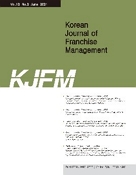 E-ISSN : 2508-4593
E-ISSN : 2508-4593
Topic Modeling of News Article Related to Franchise Regulation Using LDA
YANG, Hoe Chang
Abstract
Purpose: In 2020, the franchise industry accomplished a significant growth compared to the previous year, as the number of franchise companies increased by 9.0% while the number of franchise brands increased by 12.5%. Despite growth in size, the Korean franchise industry underwent many negative incidents, such as franchise ownership sales to private equity funds, that led to deterioration of businesses. From this point of view, this study aims to make various proposals to help policy makers develop franchise industry policies by analyzing trends of the current and previous presidential administrations' franchise policies and regulations using newspaper articles. Research design, data and methodology: A total of 7,439 articles registered in Naver API from February 25, 2013 to November 29, 2021 were extracted. Among them, 34 unrelated video articles were deleted, and a total of 7,405 articles from both administrations were used for analysis. The R package was used for word frequency analysis, word clouding, word correlation analysis, and LDA (Latent Dirichlet Allocation) topic modeling. Results: The keyword frequency analysis shows that the most frequently mentioned keywords during the previous administration include 'no-brand', 'major company', 'bill', 'business field', and 'SMEs', and those mentioned during the current administration include 'industry' and 'policy'. As a result of LDA topic modeling, 9 topics such as 'global startups' and 'job creation' from the previous administration, and 10 topics such as 'franchise business' and 'distribution industry' from the current administration were derived. The results of LDAvis showed that the previous administration operated a policy based on mutual growth of large and small businesses rather than hostile regulations in the franchise business, whereas the current administration extended the regulation related to franchise business to the employment sector. Conclusions: The analysis of past two administrations' franchise policy, it can be suggested that franchisors and franchisees may complement each other in developing the Fair Transactions in Franchise Business Act and achieving balanced growth. Moreover, political support is needed for sound development of franchisors. Limitations and future research suggestions are presented at the end of this study.
- keywords
- Franchise, Franchise Regulation, News Article, LDA, Topic Modeling
- Downloaded
- Viewed
- 0KCI Citations
- 0WOS Citations













